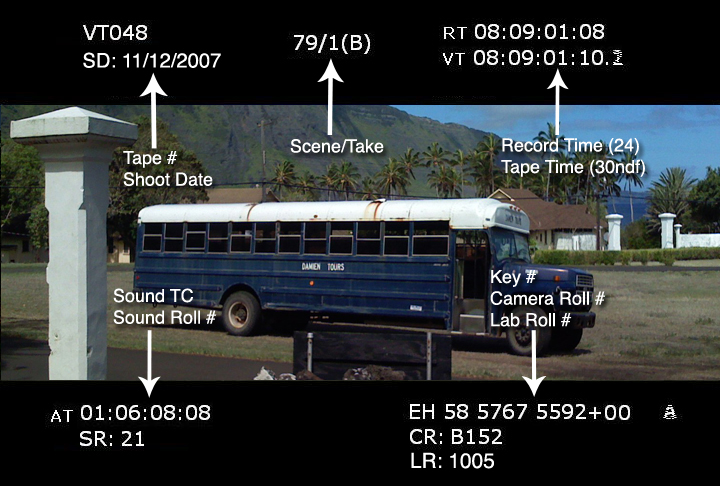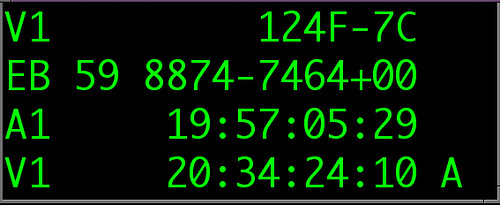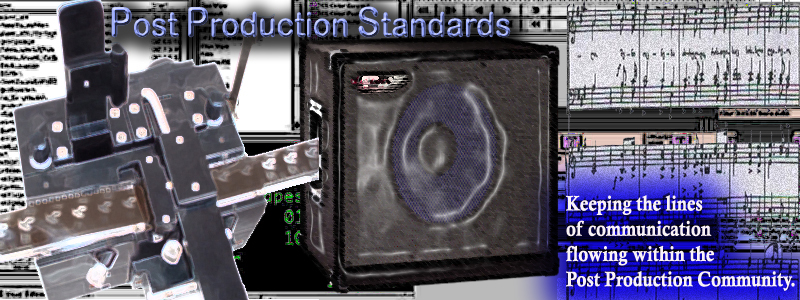These days, telecine houses can insert numerous burn-ins to your picture/mattes. I like to error on more - Key numbers, tape time code, sound time code, tape #, camera roll, lab roll and sound roll (including MOS). This gives you a great visual aid for each clip.

Scott Janush introduced me to a great way to check your key numbers, sound time code, clip name, etc. against the burn ins of your telecine - using the Time Code Window from your tools menu. This handy tool can add any column you wish and as big as you wish.
 During dailies, it is most important that you check this data and sync before you turn over the clips to your editor. Doing so will insure that the footage is perfect and fixed before it becomes part of a sequence. A lot of times, simple errors can be checked and fixed in your bin. However, say you find a key number in your data that does not match the burn. It is important to contact the telecine house and have them check the offending clip. Better safe than sorry.
During dailies, it is most important that you check this data and sync before you turn over the clips to your editor. Doing so will insure that the footage is perfect and fixed before it becomes part of a sequence. A lot of times, simple errors can be checked and fixed in your bin. However, say you find a key number in your data that does not match the burn. It is important to contact the telecine house and have them check the offending clip. Better safe than sorry.And it is becoming much more common for sound to be synced up in telcine. It is common for there to be sync issues, so fixing sync is also part of the job. In a 35mm project, you can make a subclip of the out of sync clip and use the slip perfs function to fix sync. This does not work with 16mm, so in that instance you can make a sequence of the clip, fix your sync and then select autosync from the bin menu.
If you spend that extra time checking the work of telecine before editing, you ensure an easy turnover during post-production that you can trust.
Note: There is a limitation in Avid Meridian that makes it so that you cannot check key numbers when using 3perf. This was fixed in Adrenaline.

6 comments:
During the past several years, telecine has been responsible for inputting the film information into the avid, and for creating the burn-in. Even though the key numbers in the avid may match the burn-in, the information can still be wrong.
A good check for Key numbers is to ask the lab to send punch reports to the cutting room. The lab will usually punch a hole at the heads and tails of each Camera Roll on a +00 frame for telecine prep when requested. The person who does this keeps a log. Just make sure the key numbers on the punch report log match the key numbers in your avid clip when you are parked on the corresponding punched frame. Also check the burn-in. If the numbers don’t match the punch report, call your negative cutter, or the telecine house and have them check the punched frame.
It's a good idea to check your lab roll information too. More often I am finding that the telecine houses are not accurately entering in the lab rolls. This can cause annoying problems down the road.
Excellent tip, David. Thank you.
Just a quick note to say that it is not a bug in Meridian based systems since 3 perf was rewritten in the Adrenaline code as a new feature. Meridian contained limitations that prevented Avid from counting 3 perf above the monitor.
While on the topic of KeyKode, another feature that added in recent versions is the ability to track KeyKode rollover for picture that rolls over 9999+15 (35mm) for example. Rare for Kodak, but happens frequently with Fuji (about 20% of the time. I have been told by Fuji that new stock has fixed that issue...
Michael
Thanks for the info, Michael. Thank you so much.
That was very useful information on this. Thank you for posting this!
That's real interesting. Thanks for sharing!
Post a Comment